[In the leadup to my 37th birthday, and perhaps to slightly ameliorate the pain of its arrival, now I present seven straight days of blogging on one movement of the 4th Partita of Bach, the Allemande … just to demonstrate, if I haven’t already, the extent to which I am capable of obsessing.]
Bach sees Jane run.
At the beginning of the Allemande of the 4th Partita, in the left hand, a plain Jane progression:
… which is (ho hum) the generic declarative sentence of tonal music. See the tonic run to the dominant and back, a scaredycat afraid to wander. But in the right hand I have a wanderer:
Behind the wandering “melody” hides a wonderful, arching arpeggiation:
So, schizophrenia. The left hand is saying something grammatical, prosaic, everyday, something that is common to a million pieces, a functional bit, while the right hand is radiating up a seventh, up a ninth, and then back down, fancifully testing intervallic space. This melodic behavior is not functional, in the same way that wearing a feather boa is not functional—but sometimes it just “makes” an outfit.
Bach is feeding off the contradiction, between this
Notice how after the melody completes its dangerous self, the left hand tries to bring everything in line with a nice triadic tag: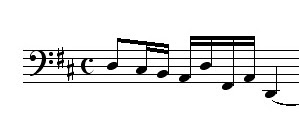
… two musical “life forces” … the triad and the seventh … they tug and stare at each other, their antagonism fed by familial connection. Bach says: triads extend themselves into seventh chords, into ninth chords, by natural chains, processes, by the course of events, by association, by simple movement, by logic which blurs into fantasy … He demonstrates: a ninth chord (wild event) is two triads (common events) smushed together, like for example two normal words whose meanings for a moment get mixed together, becoming ambiguous, even semi-scandalous. Triads extend themselves as simply as reaching out an arm … At one point (for instance) the melody shoots up to this B, it imagines itself climbing higher and higher, and pursues its imagination and finds itself where it “should not be.” 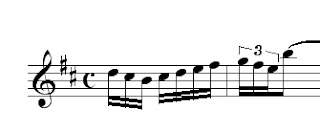
And then we must watch it fall, third by third, back down
… hiding behind the “melody,” surreptitiously but structurally, an amazing chain of thirds (the thirds which had, in fact, built the ascent) … falling, an unfolding fan, or the slow release of some pent-up breath, into itself. The high B relinquishes itself into a lower B … just as at the end of a long journey you come back to the same place, with coiled awareness of the wider world you have seen.
Yes, I am suggesting this movement has a Clark Kent and a Superman:  …triad Clark, the self-contained, the pure, with sense of limits, decorum, gravity, versus seventh-ninth Superman, tremendous limitless enchainer (this is why the sight of Superman in chains is so devastating, for he is by definition that which travels along chains, which transcends confinement) … Superman soars over that which should be painstakingly crossed. A harmony is (after all, Bach tells us) a territory which begs to be extended, an idea which wants to be questioned. The triad wears glasses, is simple, meaning-establishing, closing, codifying, works at a newspaper, establishes “facts”; its extension is complex, wondering, definition-blurring (but has issues with Kryptonite? … here, perhaps, the analogy fails).
…triad Clark, the self-contained, the pure, with sense of limits, decorum, gravity, versus seventh-ninth Superman, tremendous limitless enchainer (this is why the sight of Superman in chains is so devastating, for he is by definition that which travels along chains, which transcends confinement) … Superman soars over that which should be painstakingly crossed. A harmony is (after all, Bach tells us) a territory which begs to be extended, an idea which wants to be questioned. The triad wears glasses, is simple, meaning-establishing, closing, codifying, works at a newspaper, establishes “facts”; its extension is complex, wondering, definition-blurring (but has issues with Kryptonite? … here, perhaps, the analogy fails).
A wild thunderstorm one morning in Houston last month half woke me up, and I spent unknown groggy time lying in bed wondering, in my dream, why I couldn’t distinguish between dream and reality. Daniel Day-Lewis talked to me in the form of a giant insect about the merits (or lack thereof) of You’ve Got Mail; this seemed very real to me, like a bleary morning lecture class I used to have in physics; I thought to myself He’s a real bug, not a dream bug; and thus, somehow, I proved to myself triumphantly, arrogantly, that I was still asleep … as though I were both Socrates and his idiotic interviewee.
That same night, I played the D major Allemande as an encore, and I made a connection between my morning daze and my evening haze … Bach’s enchaining seventh and ninth chords, and the resulting transitiveness of this melody, have some connection to the ability to dream, to wander off into what, in Bach, might be regarded as the illogical, though perpetually founded on logic, springing off logic like a comfortable point of reference …
The surrender to sleep is so delicious. Too, there is something so sensually alluring about all those thirds and the beautiful dissonant notes they reach from their starting points, something alluring and spellbinding about the hopeless, fantastic, curling attempt to make them all understood. (To prove himself awake.) You can see (hear) Bach touching back on them (remember this strange note?), wanting to make sure we rehear, refeel them as he resolves or almost-resolves them. He sweeps them (I think with a little grin on his face) under the carpet as he approaches the cadence, he sweeps away the dream, saying it all fits, drawing the curtain closed … finito! … but for me it never all fits, there is always something left over, some dream-remainder of difference, some magic dust the carpet will never hide. I would say this dust, this remainder is the “meaning” of the Allemande if I didn’t feel in some weird way that whatever it is, it’s quite uncomfortable with the very word “meaning.”
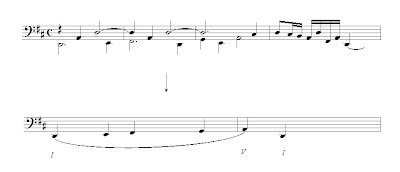


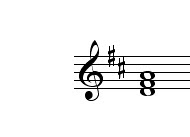
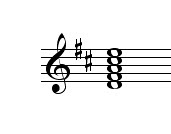



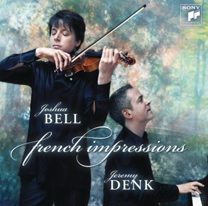

4 Comments
Now how come MY theory teachers never used action figures with us???
Thanks, Jeremy. You know that final paragraph means something to some not quite conscious part of me too.
Oh! you’re still w/ Bach? Okay, birthday boy, let’s start to count down to the final special day.
You seem to be a ‘musical Coehlo’ to me. I come to this site when I need a ‘dose’.
I’d love to own a book of yours (do you have that idea in mind at all?) with all your little essays, so I could re-read some favorite places and occasionally USE your imaginary while practicing and studying music.
thoroughly jealous to your family… you are such a gem, Jeremy!
Happy Birthday!